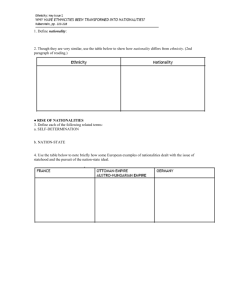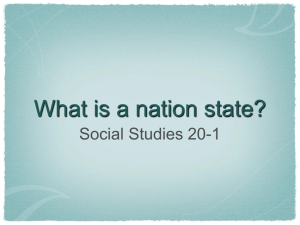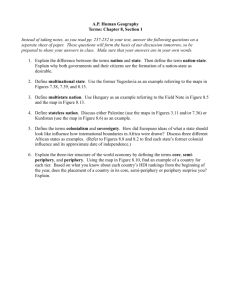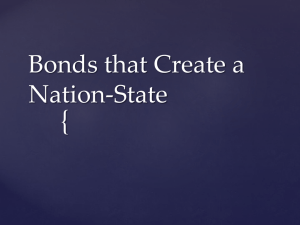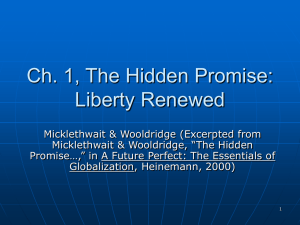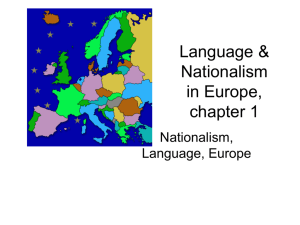AP Human Geography Unit 7-8 Test Cheltenham High School Mr
advertisement
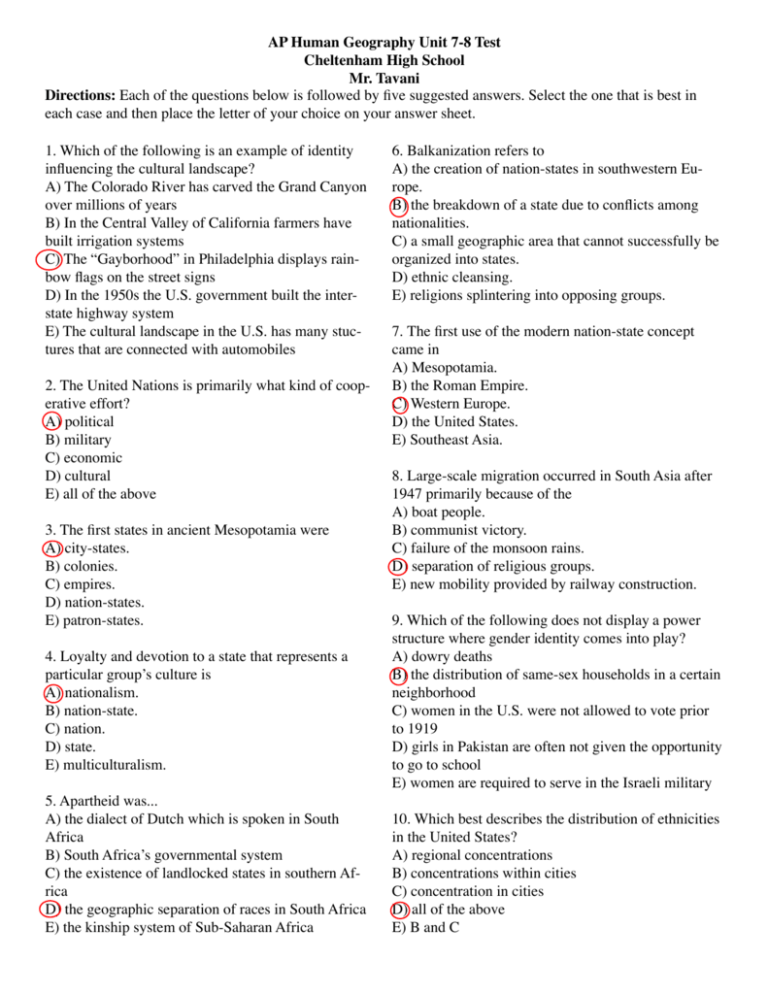
AP Human Geography Unit 7-8 Test Cheltenham High School Mr. Tavani Directions: Each of the questions below is followed by five suggested answers. Select the one that is best in each case and then place the letter of your choice on your answer sheet. 1. Which of the following is an example of identity influencing the cultural landscape? A) The Colorado River has carved the Grand Canyon over millions of years B) In the Central Valley of California farmers have built irrigation systems C) The “Gayborhood” in Philadelphia displays rainbow flags on the street signs D) In the 1950s the U.S. government built the interstate highway system E) The cultural landscape in the U.S. has many stuctures that are connected with automobiles 2. The United Nations is primarily what kind of cooperative effort? A) political B) military C) economic D) cultural E) all of the above 3. The first states in ancient Mesopotamia were A) city-states. B) colonies. C) empires. D) nation-states. E) patron-states. 4. Loyalty and devotion to a state that represents a particular group’s culture is A) nationalism. B) nation-state. C) nation. D) state. E) multiculturalism. 5. Apartheid was... A) the dialect of Dutch which is spoken in South Africa B) South Africa’s governmental system C) the existence of landlocked states in southern Africa D) the geographic separation of races in South Africa E) the kinship system of Sub-Saharan Africa 6. Balkanization refers to A) the creation of nation-states in southwestern Europe. B) the breakdown of a state due to conflicts among nationalities. C) a small geographic area that cannot successfully be organized into states. D) ethnic cleansing. E) religions splintering into opposing groups. 7. The first use of the modern nation-state concept came in A) Mesopotamia. B) the Roman Empire. C) Western Europe. D) the United States. E) Southeast Asia. 8. Large-scale migration occurred in South Asia after 1947 primarily because of the A) boat people. B) communist victory. C) failure of the monsoon rains. D) separation of religious groups. E) new mobility provided by railway construction. 9. Which of the following does not display a power structure where gender identity comes into play? A) dowry deaths B) the distribution of same-sex households in a certain neighborhood C) women in the U.S. were not allowed to vote prior to 1919 D) girls in Pakistan are often not given the opportunity to go to school E) women are required to serve in the Israeli military 10. Which best describes the distribution of ethnicities in the United States? A) regional concentrations B) concentrations within cities C) concentration in cities D) all of the above E) B and C 11. African Americans are clustered in which region of the United States? A) Southeast B) Southwest C) Plains states D) Pacific Northwest E) Northeast 12. Latinos and Hispanics are clustered in which regions of the United States? A) Northeast, cities B) West, Southwest C) Southwest, Southeast D) cities E) Pacific Northwest, Plains states 13. An exclave is A) A territory occupied predominantly by one ethnic group B) A territory controlled by another state C) A territory that is unclaimed by other states D) A territory belonging to one state that is separated from it by the territory of another state E) A territory that is completely inside another state 14. Ethnic identity for descendants of European immigrants is primarily preserved through A) neighborhoods and locations. B) schools and education. C) language. D) religion and food. E) political affiliation. 15. Which was the most dramatic change in the geographic distribution of African Americans in the United States? A) rural to urban within states B) change to sharecropping C) relocation to northern cities D) movement out of inner-cities E) relocation to coastal cities 16. Racism is belief in A) biological classification of people. B) superiority because of racial identity. C) inferiority because of racial identity. D) all of the above E) B and C 17. How can the geographic concept of “gendered spaces” be explained? A) a society’s roles for men and women B) the biological differences between men and women C) segregation based on sexual orientation D) social relations based on sexuality E) spaces that are separately designed or designated for men or women 18. People who were restricted by covenants in deeds included all but A) White Protestants. B) Jews. C) Blacks. D) Roman Catholics. E) A and B. 19. White flight is A) movement of Whites from northern cities. B) movement of Whites from southern cities. C) establishment of suburbs. D) decrease in percent Whites because of Black migration from the Southeast. E) emigration of Whites from an area Blacks were anticipated to move to. 20. Neighborhood changes in ethnicity are best explained by the promoting of A) segregation. B) separate but equal. C) blockbusting. D) self-identification. E) red lining. 21. A nation or nationality is A) a group of people tied to a place through legal status and tradition. B) a country. C) ethnic identity. D) any cohesive group of people. E) a group with shared religion, language, and origin of birth. 22. The process when an ethnic group forcibly removes another ethnic group is called A) war. B) migrational push factors. C) racism. D) ethnic cleansing. E) white flight. 23. An area organized into an independent political unit with its own population and the authority to govern its internal and external affairs is a A) colony. B) nationality. C) satellite. D) state. E) suburb. 24. Which factor has had the greatest influence in causing residential segregation in Northern Ireland? A) ethnicty B) nationality C) language D) race E) religion 25. A territory with control over its internal and external affairs has A) centripetal forces. B) nationality. C) suffrage. D) sovereignty. E) ethnicity. 26. Over the past half century, the number of sovereign states in the world A) has remained approximately the same. B) has increased by a couple of dozen. C) has decreased by a couple of dozen. D) has increased by more than a hundred. E) has increased by more than a thousand. 27. The world’s largest state is A) China. B) Canada. C) Russia. D) Alaska. E) India. 28. Korea is a good example of a A) sovereign state. B) nation-state. C) nation divided between more than one state. D) colony. E) patron-state. 29. Which of the following is NOT true about both China and Taiwan? A) Both were once ruled by the Nationalists. B) Both consider that the two areas form one sovereign state. C) Both now hold seats in the United Nations. D) Both have official relationships with the United States. E) B and C 30. Which would be a good example of identifying against? A) Hinduism binds together the majority of people in India B) Brazilians come together to cheer their football team at the world cup C) The Tarahumara view the people of the world as either one of them or as others (chabochis). D) Arab nationalism and Pan-Arabism promoted the creation of one unified Arab state E) One of Hitler’s goals was to unify all of the German speaking territories of Europe. 31. The only large land mass not part of a sovereign state is A) Antarctica. B) the Arctic. C) Greenland. D) Siberia. E) Borneo. 32. Denmark is a good example of a nation-state because A) nearly all Danes speak Danish and live in Denmark. B) Danish and German nationalities intermingle in Schleswig-Holstein. C) the people living on the Faeroe islands, which are controlled by Denmark, speak Faeroese. D) Denmark consolidated its boundaries by giving Greenland to Norway. E) all of the above 33. Political unity in the ancient Mediterranean world reached its height in A) the Fertile Crescent. B) Egypt. C) the Roman Empire. D) Western Europe. E) the Alexandrian Empire. 34. A territory tied to a state rather than being completely independent is a A) nation. B) state. C) nation-state. D) colony. E) patron-state. 35. Which of the following can be a powerful force in establishing identity? A) ethnicity B) language C) gender D) religion E) all of the above 36. The breakup of Yugoslavia during the 1990s was caused by A) ethnic cleansing. B) the assassination in Sarajevo of the heir to the throne of Austria-Hungary. C) rivalries among nationalities. D) NATO. E) espionage by Russian agents. 37. A frontier, in contrast to a boundary, A) separates two states. B) is an area rather than a line. C) has become a more common means to separate states. D) is a region of ethnic conflict. E) all of the above 38. Which shape most easily fosters the establishment of effective internal communications for a smaller state? A) compact B) elongated C) fragmented D) prorupted E) prolonged 39. The Germans established the proruption known as the Caprivi Strip in present-day Namibia for which of the following reasons? A) access to resources in central Africa B) disruption of British communications C) fighting apartheid in neighboring South Africa D) access to the Zambezi river E) A, B, and D 40. A feature of the physical environment commonly used to separate states includes all but which of the following? A) deserts B) geometry C) mountains D) lakes E) rivers 41. The concept that nationalities or ethnicities have the right to govern themselves is known as the right of A) centripetal force. B) nation-state. C) self-determination. D) sovereignty. E) ethnic identity. 42. Boundaries were redrawn in much of Europe after World War I according to the A) distribution of languages. B) demands of the victorious British and French. C) containment of Nazism. D) League of Nations. E) North Atlantic Treaty Organization. 43. Conflict is widespread in Africa in part because A) Africa is a multinational state. B) Africa is a nation-state. C) European colonial powers drew inappropriate boundaries. D) Africans belong to many tribes. E) missionaries are less active since the colonial era ended. 44. The Kurds are a A) multinational state. B) nationality divided among more than one state. C) religious minority in the Middle East. D) trying to unite with Turkey. E) all of the above 45. A state which places most power in the hands of a central government is a A) federal state. B) nation-state. C) fragmented state. D) unitary state. E) compact state. 46. Elongated states may suffer from poor internal communication and difficulty defending its borders. Which of the following is not an elongated state? A) Malawi B) Gambia C) Namibia D) Chile E) Italy 47. States cooperate with each other for what kind of reasons? A) political B) military C) economic D) all of the above E) A and C only 48. Most of the boundary between the United States and Canada is best defined by which of the following? A) geometry B) language C) water D) mountain E) A and C Free-Response Questions Answer the questions below in as great detail as you can. Be sure that you answer exactly what the question is answering of you. While a formal essay is not required, it is not enough to answer a question by merely listing facts. Illustrate your answers with substantive geographic examples where appropriate. Be sure that you number each of your answers, including individual parts, on your answer sheet, as the questions are numbered below. 2. A. Define the following concepts as they are used in political geography. 1. Nation 2. State 3. Nation-State B. For each of these concepts, name a specific late twentieth century example from Region A and a specific late twentieth century example from Region B on the map above. C. Explain how the pursuit of the nation-state idea during recent decades has led to conflict in one of the two regions on the map above (Region A or region B).

